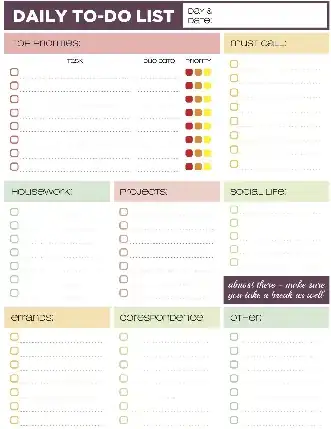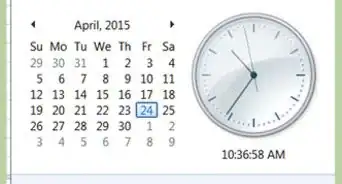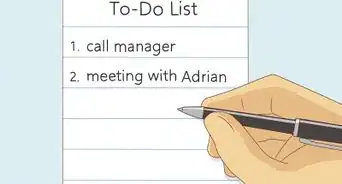This article was co-authored by Colleen Campbell, PhD, PCC. Dr. Colleen Campbell is the Founder and CEO of The Ignite Your Potential Centers, Career and Life Coaching based in the San Francisco Bay Area and Los Angeles. Colleen is an International Coach Federation accredited Professional Certified Coach (PCC). Colleen received her MA and PhD in Clinical Psychology from Sofia University and has been career coaching since 2008.
wikiHow marks an article as reader-approved once it receives enough positive feedback. In this case, 84% of readers who voted found the article helpful, earning it our reader-approved status.
This article has been viewed 361,933 times.
Sometimes it can start to seem like the whole world is crashing down. Work and school start piling up, house chores and responsibilities, commitments to friends and family--there just aren't enough hours in some days. Learning to prioritize effectively can help you become a more efficient worker, saving time, energy, and stress. Learn to organize your tasks into distinct categories and levels of difficulty, and start approaching them like a pro.
Steps
Prioritize List Template
Making Your To-Do List
-
1Choose a time-frame for your list. Do you have a particularly busy week coming up? A crazy day? Maybe thinking about everything you need to do before the end of the year is driving you nuts. Whatever the nature of your commitments, select the time-frame of the priorities list you hope to create to help you start managing those priorities and translating that stress into meaningful action.[1]
- Short-Term Goals will often include things from many different categories. You might have several things you need to finish for work by the end of the day, as well as the errands you need to run before heading home, and various things to do around the house when you get there. You could have a list of stress-causers, all things that need to be done in the next several hours.
- Long-Term Goals might include larger ambitions that will need to be broken down into multiple steps you'll also need to prioritize. You might put "apply to colleges" on a long-term to-do list, which will involve many different smaller activities. The simple act of breaking it down, though, will simplify and demystify the process.
-
2Write down everything you need to do. Start breaking it down and writing down what exactly you need to do in whatever order the things occur to you. Within the time frame that's got you stressing, select all the tasks--however big or small--that will need to be accomplished and list them out. List projects that need to be accomplished, decisions that need to be made, and errands that need to be run.Advertisement
-
3Categorize the things you need to do. It may be helpful to break everything up into separate categories, basically creating different to-do lists for the different areas of your life. House chores might be one category, while work projects or school projects may be another. If you've got a busy social life, there might be a lot going on during the weekend that you've also got to prepare for and prioritize. Create separate lists for each.
- Alternatively, if it helps you to have everything in one place, you might consider creating an over-all to-do of home chores and responsibilities, work commitments, and things necessary for your social life. If you're feeling overwhelmed, it can help to have everything juxtaposed with everything else, to let you start seeing the importance of individual tasks compared with others.[2]
-
4Put the list in order. Identify the most important or urgent activities on the list and rewrite the list with those at the top. It's all relative to you and the topics on your list, so you might decide that school activities trump work projects, or vice versa.
- Alternatively, if everything is equally important and necessary, keep the list unordered and approach it alphabetically or randomly. As long as you're actively ticking things off the list, all that matters is that you're getting things done.
- Having a list in front of you with some items crossed off can help to ease some of your stress about getting things done.
-
5Keep the list visible. Especially true for long-term lists, keep your list somewhere visible where you'll be able to use it as a reminder for what you need to finish, actively crossing out or checking off the items as you complete them.
- If you've got an analog list on a piece of paper, hang it somewhere you'll commonly look, like the refrigerator door or a bulletin board near the front door, or your office wall.
- Alternatively, you might keep a list on your desktop open while you work on other things, so you can keep it fresh in your mind and delete the items when you finish them.
- Post-it notes make for great around-the-house reminders. If you put a Post-it reminding you to work on your paper on the television screen, you'll remember to do what's important instead of wasting time doing something less productive.
Ranking Your Projects
-
1Rank the importance of each task. What are the most important things on your list? In general, you might decide that work/school tasks will outweigh social and house-hold chores, though certain outliers may exist. You've got to eat and bathe, for example, though laundry might be able to wait another day while you finish an important work project.
- Decide on a few different levels, maybe three, to rank the different tasks and criteria on your list. High, medium, and low importance tasks might be the best and simplest way to start ranking the importance of things on your list. Be judicious in deciding.
- You can also use colors to rank the items on your list. For example, you could use red to identify important or high priority items on your list, orange for items of medium importance, and yellow for items that are not pressing at all.
-
2Rank the urgency of each task. Consider upcoming deadlines and your ability to work within those deadlines. What needs to be done the soonest? What needs to be done by the end of the day? What might you be able to buy a bit more time on?
- It's important to consider the length of time it takes you to accomplish each of the tasks, maybe even assigning a set time to certain things. If you consider it a priority to exercise every day, but you've got a crazy amount of work to do, give yourself an exercise cap of 30 minutes and find somewhere to fit it in.
-
3Rank the effort required for each task. It might be critical that you get something to post-office by the end of the day, but this isn't a terrifically difficult task. Rank everything on your list in terms of its difficulty so you'll know how to situate it in relation to other tasks.
- It might be effective to use levels like Difficult, Moderate, and Easy to rank them, rather than trying to judge them in relation to one another. Don't worry about putting them in order before you've given each item its own rating, if it's helpful to do so.
-
4Compare all the tasks and order the list. Put at the top of the list the most important and urgent tasks that will require the least amount of effort to try to maximize your work in the time you've allotted for it.
Attacking the List
-
1Do one thing at a time and see it through to completion. It's difficult to work your way through the list by cherry-picking and doing a little bit of everything. After several hours, your list will look just like it looks now: incomplete. Instead of working in little bits, do one thing until it's finished and then move to the next thing on your list after a short break. Don't work on something else on the list until you're finished with the first and most important things.
- Alternatively, you can look for projects from multiple lists that might be effectively combined. While it may not be a great idea to try to review your math notes and write your history paper at the same time, you might be able to sit at the laundromat and wait for your clothes to dry while studying, saving time getting important tasks finished.[3]
- Try to do your most important or challenging tasks when you're most energized.[4]
-
2Decide what to delegate and what to let slide. If the Internet is on the fritz at your house, it may be tempting to head to the library, start reading up on wi-fi so you can diagnose the problem from scratch, but not if you've got to finish cooking dinner, grade twenty papers by the next morning, and do fifty other things. Might it be better to call the cable company instead?
- It's ok to decide something just isn't worth the time, or that delegating a task at a cost outweighs the time you might spend on it. You could buy new expensive fence wire, or you could salvage your own by combing through the junkyard painstakingly, sifting through rough scrap for several hours in the hot sun, but if it only turns out to be a few bucks of savings, it might be more worth it to buy new wire.
-
3Alternate the variety of tasks on your list. Breaking up the sorts of activities you do will help keep you fresh throughout your tasks and help you move through your list more quickly. Alternate a homework list with a housework list to be the most effective worker you can be. Take short breaks between them and do different tasks. You'll stay fresh and efficient.
-
4Start with the least desirable or the hardest tasks. Depending on your temperament, it can be good for your own morale if you accomplish the thing first that you're looking forward to the least. It might not necessarily be the hardest or the most important thing, but getting it out of the way to save the less painful activities for later could be effective for some people.
- Your English essay might be more important than your math homework, but if you really hate math, get it out of the way first so you can clear out all the time you need to devote solely to the essay, giving it your full, unfettered attention.
-
5Let importance trump urgency in some cases. You might have a situation in which you've only got 10 minutes to get all the way across town to the library to pick up the new disc of Game of Thrones you ordered, making it the most urgent thing on your list, but that time might be better spent doing the more-important task of getting to work on your English essay. You'll have bought yourself more time by waiting to pick up your DVD until the next day when you might have more time for it.
-
6Cross tasks off the list as you complete them. Congratulations! As you move through the list, take a glad moment to cross each thing off, deleting it from the file, or aggressively cutting it off the paper with a rusty pocketknife and ceremonially setting the scrap on fire. Take a minute to reward yourself for each little accomplishment. You're doing it!
Expert Q&A
Did you know you can get expert answers for this article?
Unlock expert answers by supporting wikiHow
-
QuestionHow do I prioritize my school work?
 Klare Heston, LCSWKlare Heston is a Licensed Independent Clinical Social Worker based in Cleveland, Ohio. With experience in academic counseling and clinical supervision, Klare received her Master of Social Work from the Virginia Commonwealth University in 1983. She also holds a 2-Year Post-Graduate Certificate from the Gestalt Institute of Cleveland, as well as certification in Family Therapy, Supervision, Mediation, and Trauma Recovery and Treatment (EMDR).
Klare Heston, LCSWKlare Heston is a Licensed Independent Clinical Social Worker based in Cleveland, Ohio. With experience in academic counseling and clinical supervision, Klare received her Master of Social Work from the Virginia Commonwealth University in 1983. She also holds a 2-Year Post-Graduate Certificate from the Gestalt Institute of Cleveland, as well as certification in Family Therapy, Supervision, Mediation, and Trauma Recovery and Treatment (EMDR).
Licensed Social Worker You can prioritize your schoolwork by using a calendar and noting all your assignments and tests. Then you can make a list with the most imminent assignments and studying from 1-10. For example, you want to first complete an assignment that is due tomorrow before starting on a paper that is due in 10 days. But you also want to build in working gradually on a larger assignment.
You can prioritize your schoolwork by using a calendar and noting all your assignments and tests. Then you can make a list with the most imminent assignments and studying from 1-10. For example, you want to first complete an assignment that is due tomorrow before starting on a paper that is due in 10 days. But you also want to build in working gradually on a larger assignment. -
QuestionWhy do we need to prioritize?
 Klare Heston, LCSWKlare Heston is a Licensed Independent Clinical Social Worker based in Cleveland, Ohio. With experience in academic counseling and clinical supervision, Klare received her Master of Social Work from the Virginia Commonwealth University in 1983. She also holds a 2-Year Post-Graduate Certificate from the Gestalt Institute of Cleveland, as well as certification in Family Therapy, Supervision, Mediation, and Trauma Recovery and Treatment (EMDR).
Klare Heston, LCSWKlare Heston is a Licensed Independent Clinical Social Worker based in Cleveland, Ohio. With experience in academic counseling and clinical supervision, Klare received her Master of Social Work from the Virginia Commonwealth University in 1983. She also holds a 2-Year Post-Graduate Certificate from the Gestalt Institute of Cleveland, as well as certification in Family Therapy, Supervision, Mediation, and Trauma Recovery and Treatment (EMDR).
Licensed Social Worker
-
QuestionWhat is prioritization?
 Klare Heston, LCSWKlare Heston is a Licensed Independent Clinical Social Worker based in Cleveland, Ohio. With experience in academic counseling and clinical supervision, Klare received her Master of Social Work from the Virginia Commonwealth University in 1983. She also holds a 2-Year Post-Graduate Certificate from the Gestalt Institute of Cleveland, as well as certification in Family Therapy, Supervision, Mediation, and Trauma Recovery and Treatment (EMDR).
Klare Heston, LCSWKlare Heston is a Licensed Independent Clinical Social Worker based in Cleveland, Ohio. With experience in academic counseling and clinical supervision, Klare received her Master of Social Work from the Virginia Commonwealth University in 1983. She also holds a 2-Year Post-Graduate Certificate from the Gestalt Institute of Cleveland, as well as certification in Family Therapy, Supervision, Mediation, and Trauma Recovery and Treatment (EMDR).
Licensed Social Worker
Supplies
- Pencil
- Paper
- Highlighter
Warnings
- Your own safety and the safety of others is the first priority in all tasks.⧼thumbs_response⧽
- Your personal life, happiness, and integrity should be at the top of your priority list.⧼thumbs_response⧽
References
- ↑ https://www.topuniversities.com/blog/7-time-management-tips-students
- ↑ https://hbr.org/2021/01/i-tried-4-to-do-list-methods-heres-what-worked
- ↑ https://www.apa.org/topics/research/multitasking
- ↑ Colleen Campbell, PhD, PCC. Career & Life Coach. Expert Interview. 28 March 2019.
- ↑ Colleen Campbell, PhD, PCC. Career & Life Coach. Expert Interview. 28 March 2019.
About This Article
To prioritize, start by writing down a list of things you need to do within a certain timeframe, whether it's a day or a week. Then, rank the items on your list into three categories: high, medium, and low importance. Next, identify any tasks that can wait so you can accomplish more urgent matters, such as deciding to put off the laundry for a day so you can meet your work deadline. Additionally, put the most urgent tasks that require the least effort at the top of your list as this will allow you to reduce your list quickly. For tips on how to delegate tasks and how to keep track of your list, keep reading!































-Step-8.webp)
















































